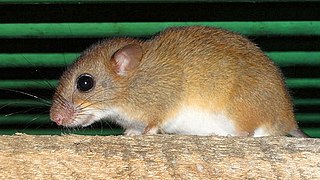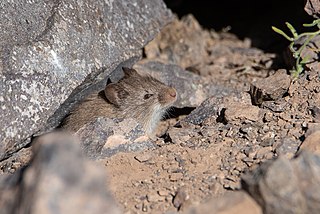Cerradomys subflavus, also known as the terraced rice rat or flavescent oryzomys, is a rodent species from South America in the genus Cerradomys. It is found in the states of Goiás, São Paulo, and Minas Gerais, Brazil. Populations in Bolivia, Paraguay, and elsewhere in Brazil that were previously placed in this species are now classified as various other species of Cerradomys.

Oecomys bicolor, also known as the white-bellied oecomys or bicolored arboreal rice rat, is a species of rodent in the genus Oecomys of family Cricetidae. It has a wide distribution in the Amazon biome, occurring in northwestern Brazil, northern Bolivia, eastern Peru, eastern Ecuador, eastern Colombia, much of Venezuela, Guyana, Suriname, and French Guiana, and extends into eastern Panama, but it may contain more than one species.
Oecomys cleberi, also known as Cleber's oecomys or Cleber's arboreal rice rat, is a species of rodent in the genus Oecomys of family Cricetidae. Known only from the Federal District in Brazil, its taxonomic status relative to O. concolor and O. paricola is unresolved.

Oecomys concolor, also known as the unicolored oecomys, unicolored rice rat, or unicolored arboreal rice rat, is a species of rodent in the genus Oecomys of family Cricetidae. It is found in tropical rainforest in the Amazon biome, but its range is poorly documented; it has been recorded in northwestern Brazil, southeastern Colombia, and southern Venezuela.
Oecomys paricola, also known as the Brazilian oecomys, Brazilian arboreal rice rat, or South Amazonian arboreal rice rat, is a species of rodent in the genus Oecomys of family Cricetidae. It is found in northeastern Peru as well as central Brazil south of the Amazon, where it lives in lowland tropical rainforests.
Oecomys rex, also known as the regal oecomys or king arboreal rice rat, is a species of rodent in the genus Oecomys of family Cricetidae. It is found in Guyana, Suriname, French Guiana, and nearby parts of Venezuela and Brazil.

Oecomys trinitatis, also known as the long-furred oecomys, long-furred rice rat, Trinidad arboreal rice rat, or big arboreal rice rat, is a species of rodent in the genus Oecomys of family Cricetidae. As currently constituted, it has a wide distribution in Central America and South America, being found in southern Costa Rica, Panama, Colombia, Venezuela, Trinidad and Tobago, Guyana, Suriname, French Guiana, much of Brazil, eastern Ecuador, and eastern Peru.

Oecomys is a genus of rodent within the tribe Oryzomyini of family Cricetidae. It contains about 17 species, which live in trees and are distributed across forested parts of South America, extending into Panama and Trinidad.
Akodon aerosus, also known as the highland grass mouse or Yungas akodont, is a species of rodent in the family Cricetidae. It is found in the eastern Andes from eastern Ecuador through Peru into central Bolivia.

Akodon albiventer, also known as the white-bellied grass mouse or white-bellied akodont, is a species of rodent in the family Cricetidae. It is found in the Andean highlands from southeastern Peru to southwestern Bolivia, northwestern Argentina, and far northeastern Chile at elevations from 2400 m to over 5000 m.
Akodon boliviensis, also known as the Bolivian grass mouse or Bolivian akodont, is a species of rodent in the family Cricetidae. It is found in the Andes from southeastern Peru through Bolivia into northwestern Argentina.
Oecomys flavicans, also known as the tawny oecomys or yellow arboreal rice rat, is a species of rodent in the genus Oecomys of family Cricetidae. It is found in the mountains of northwestern Venezuela and nearby Colombia.
Oecomys phaeotis, also known as the dusky arboreal rice rat or dusky oecomys, is a species of rodent in the genus Oecomys of family Cricetidae. It is found on the eastern slopes of the Andes of Peru, at 1500 to 2000 m altitude.
Oecomys rutilus, also known as the reddish oecomys or red arboreal rice rat, is a species of rodent in the genus Oecomys of family Cricetidae. It is found in Guyana, Suriname, French Guiana, and nearby regions of Brazil and Venezuela.
Oecomys speciosus, also known as the savannah oecomys, arboreal rice rat, or Venezuelan arboreal rice rat, is a species of rodent in the genus Oecomys of family Cricetidae. It ranges over northeastern Colombia and much of Venezuela, including the island of Trinidad. This rodent lives in tropical rainforest and tropical dry forest, including secondary forest and gallery forest, as well as in savanna habitat.
Oecomys superans, also known as the large oecomys or foothill arboreal rice rat, is a species of rodent in the genus Oecomys of family Cricetidae. It is found along the eastern slope of the Andes in southern Colombia, Ecuador, and Peru and east into the Amazon basin, including parts of Brazil. Its distribution is poorly known, and it may also occur further south, into Bolivia.
Nephelomys albigularis, also known as the white-throated oryzomys or Tomes's rice rat, is a species of rodent in the genus Nephelomys of family Cricetidae. Described in 1860, it was the first Nephelomys species to be discovered. It was originally described in the defunct genus Hesperomys as Hesperomys albigularis and considered related to the much smaller H. longicaudatus. By 1894, it was placed in Oryzomys, as Oryzomys albigularis, and associated with what is now Nephelomys meridensis. In the early 1960s, the scope of the species was considerably expanded to include most of the species that are now in Nephelomys, as well as a single name, boliviae, that is currently a synonym of Euryoryzomys nitidus. From 1976 on, several of these were reinstated as separate species.
Oxymycterus hucucha, also known as the Quechuan hocicudo, is a species of rodent in the genus Oxymycterus of family Cricetidae from South America. It is found only in a small region of the Andes in central Bolivia, where it lives in cloud forest at altitudes from 2600 to 3000 m.

Oecomys sydandersoni is an arboreal species of rodent in the genus Oecomys. It lives in forest patches in a small area in eastern Bolivia. It is a medium-sized species, weighing about 45 g (1.6 oz), with mostly grayish and brownish fur and short and broad hindfeet with well-developed pads.
Eutrombicula batatas is a species of chigger.





